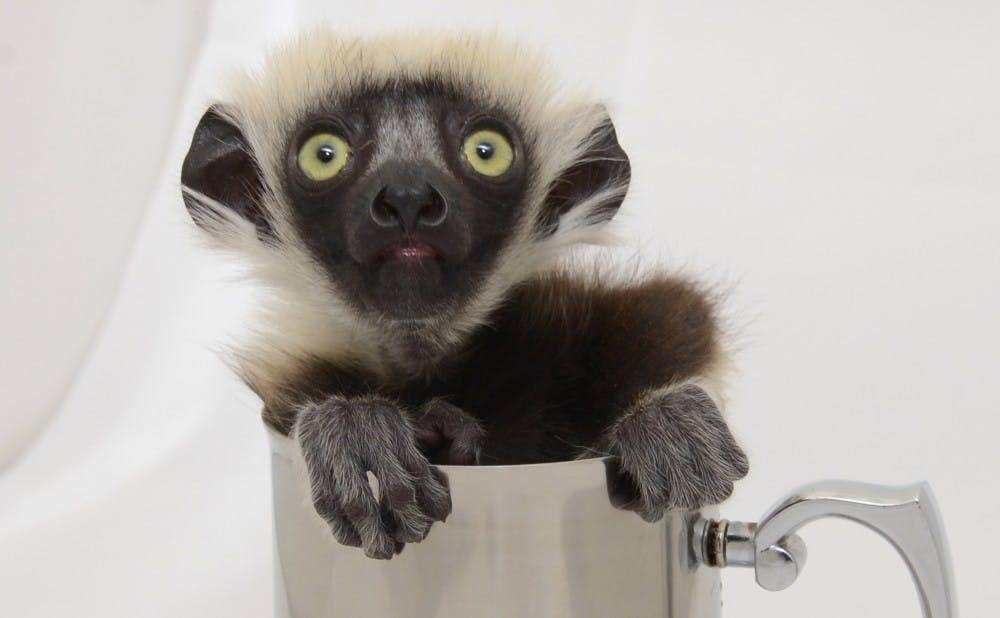Tourists visiting the Duke Lemur Center will have the opportunity to see newborn baby lemurs as a newly added attraction this summer.
The Duke Lemur Center recently welcomed 10 lemur babies born to mothers already living in the Center, with more on the way. These births are a rare event in the endangered lemur world. The Center has seen an increase in numbers of tours requested this summer, and the babies are the main reason behind this popularity.
“No one has ever told me to skip babies [during tours], and they groan when I say it’s time to leave,” said Christopher Smith, an education specialist and tour guide at the Lemur Center.
Robin Smith, science writer at the Duke Lemur Center, added that the newborn babies stay behind the scenes and spend time bonding with their parents before they are released for public display.
A number of babies were just released into the Duke Forest, where lemurs roam freely for the first time this season.
“If you were to go the Lemur Center, you can watch [the babies] as they ride on their mom’s bellies or on their backs,” Robin Smith said. “You can also see them interacting with their dad and their siblings, who are also out in the forest with them.”
Two twin ring-tailed lemur babies—one of the most easily recognizable genuses to the general public—were among the newborns at the Center.
Jovian, the star of the kids’ show Zoboomafoo, is the father of Gertrude, one of the newborn baby lemurs.
“I think [Jovian]’s passed some of his Hollywood personality off to Gertrude,” Christopher Smith said. “She’s playful, comfortable around people even at four months old and likes to show off her playful jumping and wrestling skills.”
Aemelia, another lemur infant, is about the same age as Gertrude.
“[Aemelia] is more shy and reserved, preferring to stay on mom’s back than jump and swing around so much,” Christopher Smith said.
Aemelia, Gertrude and Eleanor are three newborn babies belonging to the genus Sifaka of Madagascar, one of the most endangered primate species, Robin Smith noted.
“Fewer than ten of these guys are born in North America this year,” Robin Smith said, “so those three are pretty special.”
The newest baby is Oscar, a mongoose lemur born four weeks ago. Chrisopher Smith noted that Oscar spends much time clinging to his mom Carolina.
“I think he’ll grow up to be a little rowdy lemur,” Christopher Smith said. “Mongoose lemurs are also considered endangered, like many lemurs, so every new birth is invaluable to lemur conservation.”
The Duke Lemur Center is also home to the only two breeding female blue-eyed black lemurs in North America, Robin Smith said. One of the two females gave birth to a baby boy this March, who is named Kevin Bacon, after the blue-eyed celebrity.
Sophomore Jacqueline Anderson, a work-study at the Lemur Center, works shifts to check on the newborn babies.
“I will go and sit for about an hour to make sure that the babies are being nursed by their mom,” Anderson said. “The newborn babies spend a while only with their moms after they are born, and are slowly introduced to the rest of the family later.”
Christopher Smith said baby lemurs are the best way of displaying the Center’s efforts towards lemur preservation.
“Baby lemurs give visitors hope for the future for lemurs and emphasize that what we’re doing at the Lemur Center is good for lemurs here and in Madagascar. Everyone gets to leave with a warm, fuzzy feeling,” he said.
Summer is also the busiest season of the year for the Lemur Center. Christopher Smith anticipated that this summer will even be the busiest in the history.
“‘IMAX Island of Lemurs’ is in theaters, lemur conservationists are in the news winning awards, we’re reaching totally new audiences that didn’t know we existed,” he said.
The Duke Lemur Center is hosing its semi-annual Lemurpalooza June 6. All the new lemurs available for symbolic adoption through the center’s Adopt-a-Lemur program are open for visits.
“Last year, more than 250 people visited and we raised a lot of support for the lemurs,” Christopher Smith said.
Get The Chronicle straight to your inbox
Signup for our weekly newsletter. Cancel at any time.

